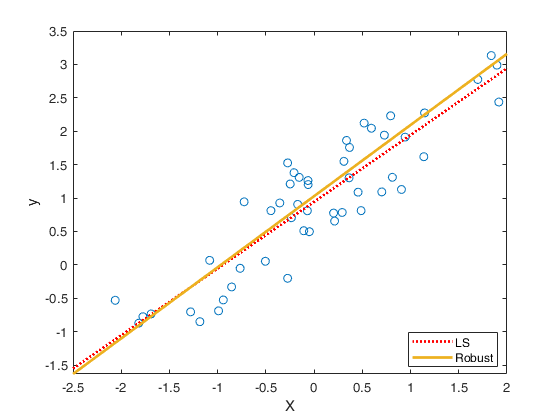RobCov
RobCov computes covariance matrix of robust regression coefficients
Description
Under some regularity conditions, robust (S and MM) estimates are asymptotically normal, thereby allowing for Wald-type tests and confidence intervals. The covariance matrix of the estimated parameters \[ cov(\hat \beta)= q^2 \times \sigma^2 \times v \times V_X^{-1} \]
consists of four parts: 1) $q$ a correction factor for the scale estimate;
2) $\sigma$ the scale parameter.
3) $v$ a correction factor depending on the $\psi$ function which is used;
4) $V_X$= a matrix part. For OLS $V_X=X'X$. Given that in robust regression we give a weight to each observation, the matrix $X'X$ should be replaced by something like $X'WX$, where $W$ is a diagonal matrix containing the weights assigned to each observation.
The purpose of this function is to provide the user with different options for the estimate of $cov(\hat \beta)$ where $\hat \beta$ is a vector of regression coefficients obtained using S or MM estimation and a particular $\rho$ function.
Examples
Related Examples
Input Arguments
Output Arguments
References
Maronna, R.A., Martin D. and Yohai V.J. (2006), "Robust Statistics, Theory and Methods", Wiley, New York.
Huber, P.J. and Ronchetti, E.M. (2009), "Robust Statistics, 2nd Edition", Wiley.
Maronna, R.A., and Yohai V.J. (2010), Correcting MM estimates for fat data sets, "Computational Statistics and Data Analysis", Vol. 54, pp. 3168-3173.
Koller, M. and W. A. Stahel (2011), Sharpening wald-type inference in robust regression for small samples, "Computational Statistics & Data Analysis", Vol. 55, pp. 2504-2515.
Croux, C., Dhaene G., and Hoorelbeke D. (2003), Robust standard errors for robust estimators. Technical report, Dept. of Applied Economics, KU Leuven.
Salini, S., Laurini, F., Morelli, G., Riani M. and Cerioli A. (2022), Covariance matrices of S robust regression estimators, Journal of Statistical Computation and Simulation, Vol. 92, pp. 724-747, https://doi.org/10.1080/00949655.2021.1972300
 An example of the need of using covrobc.
An example of the need of using covrobc.